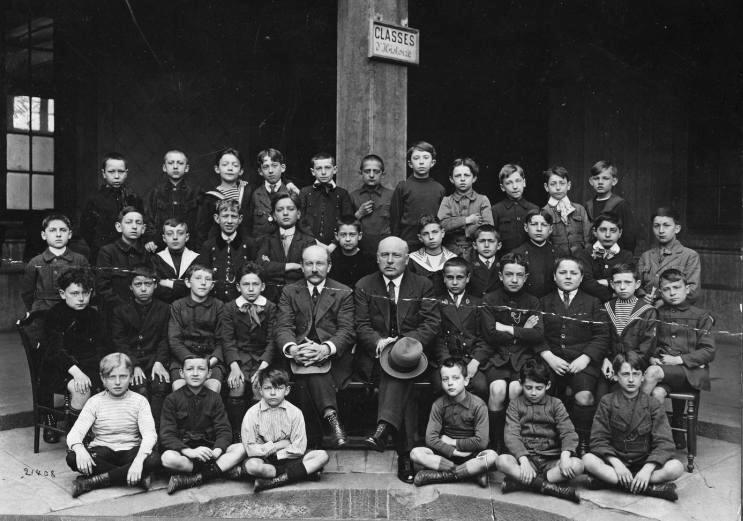
French School Terminology: Lycée

Figure 1.--The lycée in modern France is rather like a senior high school with the last 3 years of secondary education. It is an academic program leading to the university and other advanced education. Earlier, lycée was more generally used. It was for example, a general term for an academically oriented secondary school, rather like a British grammar school. Here we see the 2eme (seciond) year class at the Lycée de Saint Etienne (Stephen) in 1920. The name sounds like a Catholic school, but note there is no priest. Saint Etinne is a city southwest of Lyon and thus this was a state lycée. French children this age are no longer taught in a lycée.
|
|
Lycée is anither common term for school. We are a little confused by the term. As far as we can tell, it seems to be a term whose meaning has changed over time. The use of the term in the 20th century is generally to designate a secondary school. We note a dictionary definition, "A French lyceum, or secondary school for students intermediate between elementary school and college, supported by the French government, for preparing students for the university. We note quite young boys attending lycées in the 19th and early-20th centuries. We think the term was used variously in the 19th century. By the late-19th and early-20th century,lycée seems to have come to mean a secondary school rather like a British British grammar (secondary) schools which children began at about age 11. In modern Francem lycée has come to mean the upper section of a secondary school, rather like a senior high school in the United States. The lycées in France today provide a 3-year course of additional secondary education for children between the ages of 15 and 18 years. The three years are: 2de--Seconde (15-16 years of age), 1e--Première (16-17 years), and 1ale--Terminale (17-18 years). Pupils are prepared for the baccalauréat, colloquially known as 'le bac'. The baccalauréat can lead to the unioversity or other higher education studies. Some graduates seek jobs after obtaining their baccalauréat. A factor in the changes in terminology at French schools is probably tied up with the expansion of the secondary school system in France, especially after World war II.
HBC-SU

Related Chronolgy Pages in the Boys' Historical Web Site
[Main Chronology Page]
[The 1880s]
[The 1930s]
[The 1940s]
[The 1950s]
[The 1960s]
[The 1970s]
[The 1980s]
Related Style Pages in the Boys' Historical Web Site
[Main school uniform page]
[Main country page]
[Long pants suits]
[Short pants suits]
[Socks]
[Eton suits]
[Jacket and trousers]
[Blazer
[School sandals]
Navigate the Boys' Historical Clothing School Uniform Pages
[Return to the Main French school terminology page]
[Return to the Main French school type page]
[Australia]
[England]
[France]
[Germany]
[Italy]
[Japan]
[New Zealand]
[Scotland]
[United States]
Navigate the Boys' Historical Clothing Web Page
[Introduction]
[Activities]
[Biographies]
[Chronology]
[Clothing styles]
[Countries]
[Bibliographies]
[Contributions]
[FAQs]
[Glossaries]
[Images]
[Links]
[Registration]
[Tools]
[Boys' Clothing Home]
Created: 9:48 PM 6/12/2011
Last updated: 9:48 PM 6/12/2011




